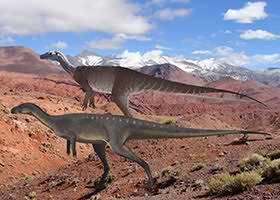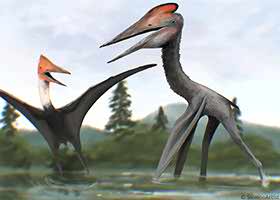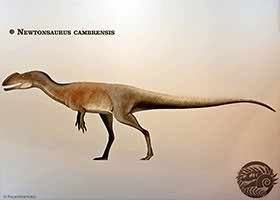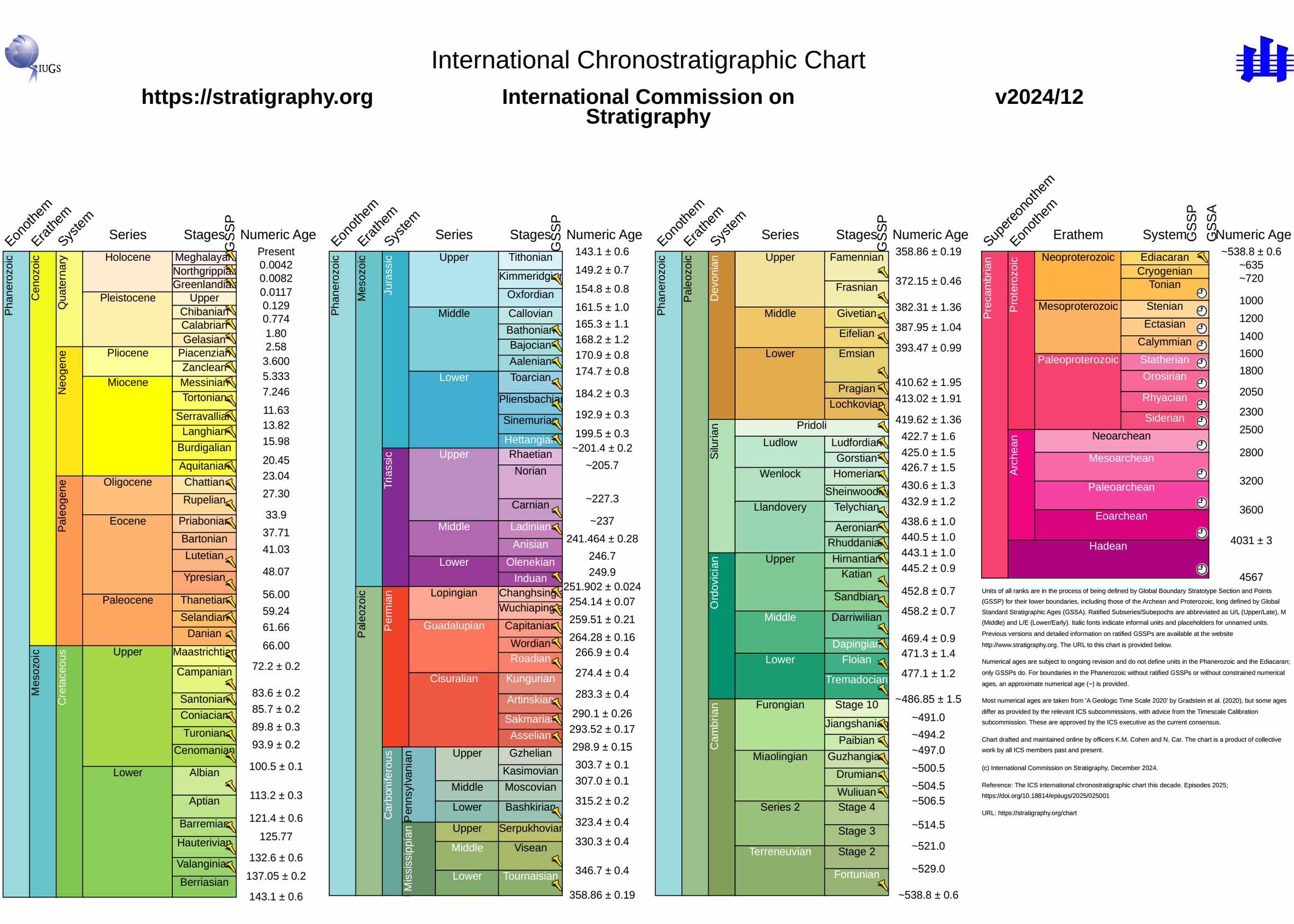
The geologic time scale, in schematic form, represents the entire history of planet Earth. Specifically, it records the sequence of key geological events: from powerful volcanic eruptions that left layers of igneous rocks to the slow accumulation of sediments on the floors of ancient seas, forming sedimentary strata. The timescale also reflects the stages of biological development in the form of fossil remains and traces of ancient creatures preserved in these rocks. In short, only within the context of geologic time can we truly understand how living organisms evolved.
Geologic Time Scale: Earth’s Chronicle
The geologic time scale is a unique chronicle that unveils the history of our planet. Crucially, it reveals how the Earth’s crust formed and life evolved, from the earliest microorganisms to complex modern ecosystems. This scale is like a map where each layer of rock and fossil tells the story of millions of years of geological and biological change. The scale relies on stratigraphy, which studies the sequence of rock layers, and paleontology, which examines the fossil remains of ancient animals and plants.
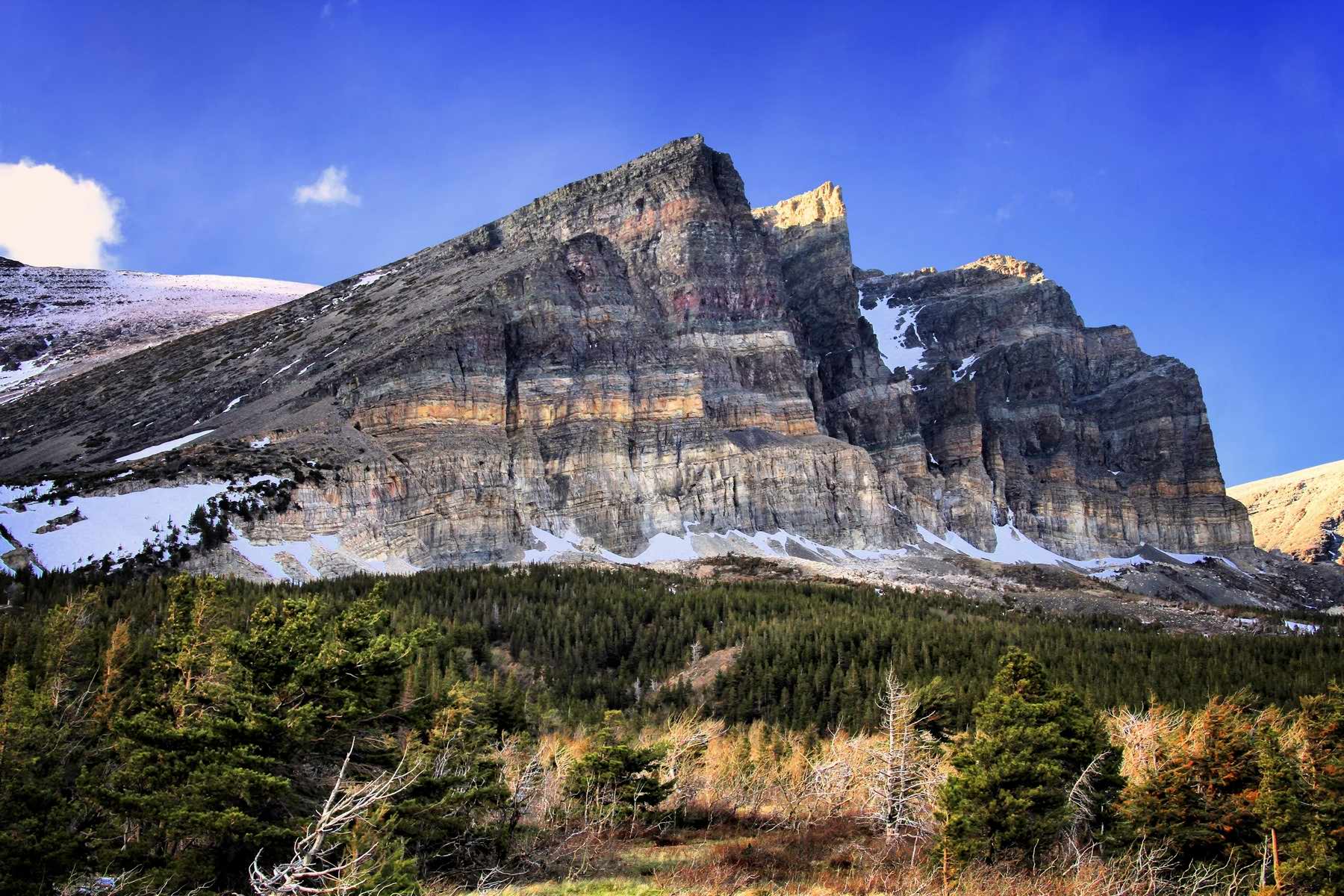
Spanning billions of years, the geologic time scale allows us to see and understand the mechanisms and rates of life’s evolution. Each stage in this scale corresponds to a specific period in Earth’s history, marked by events of significant evolutionary or geological changes, such as the formation of supercontinents, glaciations, mass extinctions, or the emergence of new species. For instance, by comparing fossils in different rock layers, scientists have identified epochs when the first tetrapods ventured onto land, when dinosaurs dominated the planet, or when mammals began to emerge. The deposits formed during these stages form the basis of the stratigraphic scale.
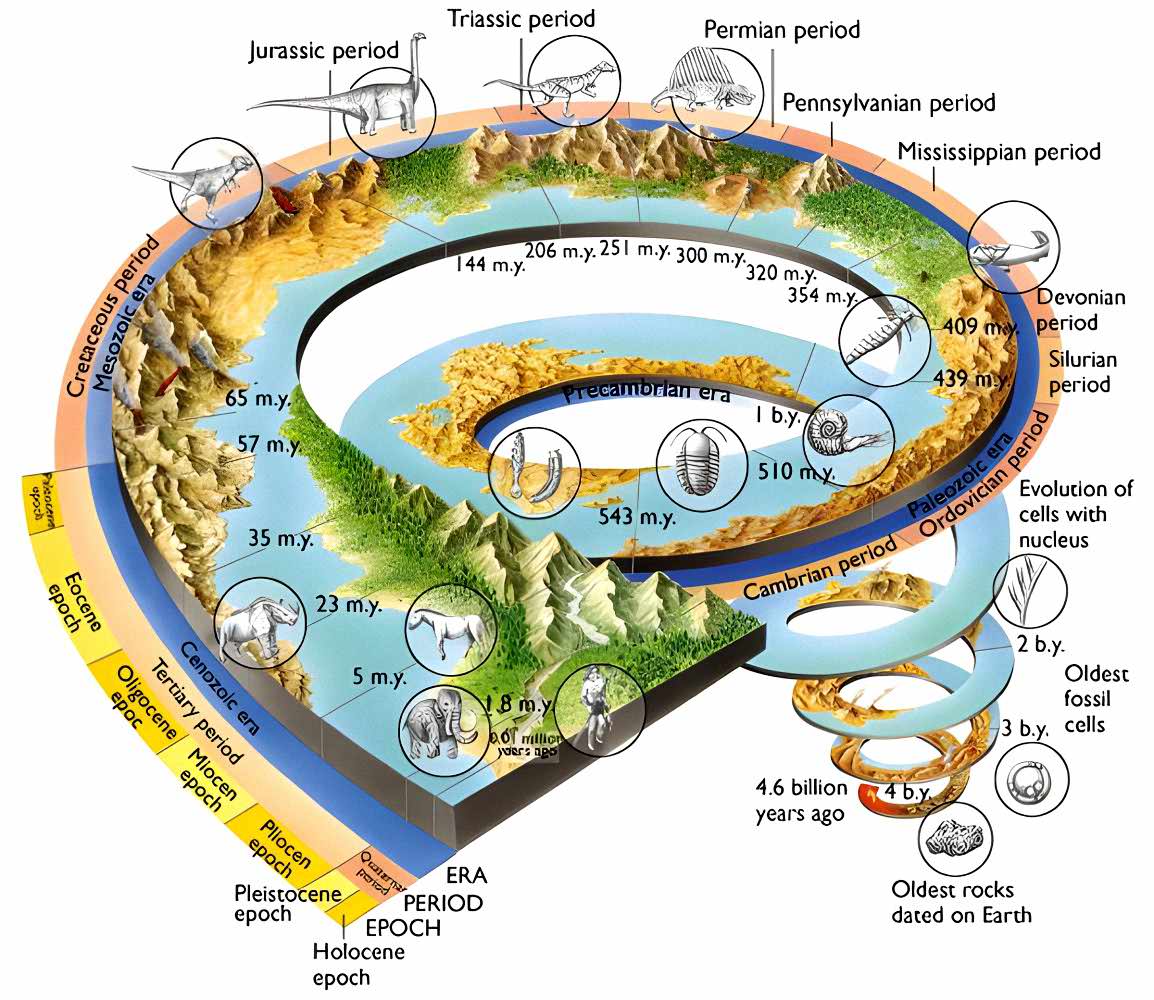
Geochronology, the science of determining the age of rocks, helps precisely date these events. The paleontological method plays a key role here: fossils found in sedimentary rocks serve as time markers, enabling the correlation of layers from different parts of the world. Thus, the geologic time scale becomes a universal tool that ties Earth’s past into a single cohesive history.
History of the Geologic Time Scale
Geologists knew the general sequence of geological systems (the geologic time scale) and their characteristic fossil assemblages in broad outline as early as the 18th century.

Among the first creators of the geologic time scale were scientists from Denmark: Inge Lehmann; from Germany: G. S. Füshel, Abraham Gottlob Werner, and Alexander von Humboldt; from Italy: Giovanni Arduino; and also from England: Roderick Murchison and Adam Sedgwick. The idea of the geologic time scale belongs to the English engineer William Smith (1769–1839).

The hierarchy and nomenclature of most modern geochronological subdivisions were adopted in the second half of the 19th century during the 2nd through 8th sessions of the International Geological Congress (IGC) in 1881–1900.
Modern Advances and International Standardization in Geologic Timekeeping
The transition to a quantitative time scale began with Arthur Holmes, who formulated his first modern time scale in 1911. Radioactive decay was discovered as early as 1896, and Rutherford in 1905 first proposed using data on the rate of radioactive decay for precise dating in geology. Holmes, considered the father of geochronology, was a pioneer in applying uranium-lead dating to assign numerical ages to rocks. In his 1913 booklet The Age of the Earth, he advocated the concept of a deep time scale, enabling scientists to confirm Earth’s age in billions of years and resolving longstanding geological debates. Holmes continued refining his work, publishing the final edition in 1960.
The integration of stratigraphy with absolute numerical dating largely defines the modern history of the geologic time scale (GTS).
A key milestone was the development of radiometric methods in the mid-20th century, which made it possible to refine the boundaries of geological periods and epochs. The emergence of magnetostratigraphy, isotopic geochronology, and biostratigraphic correlations further enhanced the scale’s precision. Significantly, this development enabled the first determination of the absolute age of rocks, definitively establishing Earth’s immense antiquity and transforming the GTS from a purely relative sequence into a quantitatively measurable time scale.
This scientific breakthrough made it possible in the 1950s to begin global correlation of stratigraphic data, which required international agreement on terms and boundaries. Consequently, the establishment of the International Union of Geological Sciences (IUGS) in 1961 directly led to the formation of the International Commission on Stratigraphy (ICS).
International Commission on Stratigraphy (ICS)

To ensure that geologists around the world “speak the same language,” a unified system for reckoning time in Earth’s history is essential. The International Commission on Stratigraphy (ICS), the largest and oldest subdivision of the International Union of Geological Sciences (IUGS), addresses this task. One of the key activities of the ICS is the creation of a global table of stratotypes—known as GSSPs (Global Boundary Stratotype Sections and Points). Essentially, these serve as the foundation for the International Chronostratigraphic Chart, a kind of “official calendar” of geological history.
The primary goal of the ICS is to precisely define and internationally agree upon global stratigraphic units—such as systems, series, and stages—by correlating them with the absolute ages of rocks. These units form the basis for larger temporal categories: eons, eras, periods, and epochs, which together constitute the Geologic Time Scale. Due to this work, scientists can confidently correlate geological events that occurred in different parts of the planet and construct a unified picture of Earth’s evolution.
Each year, at least one new version is published, incorporating all changes approved by the ICS since the release of the previous version.
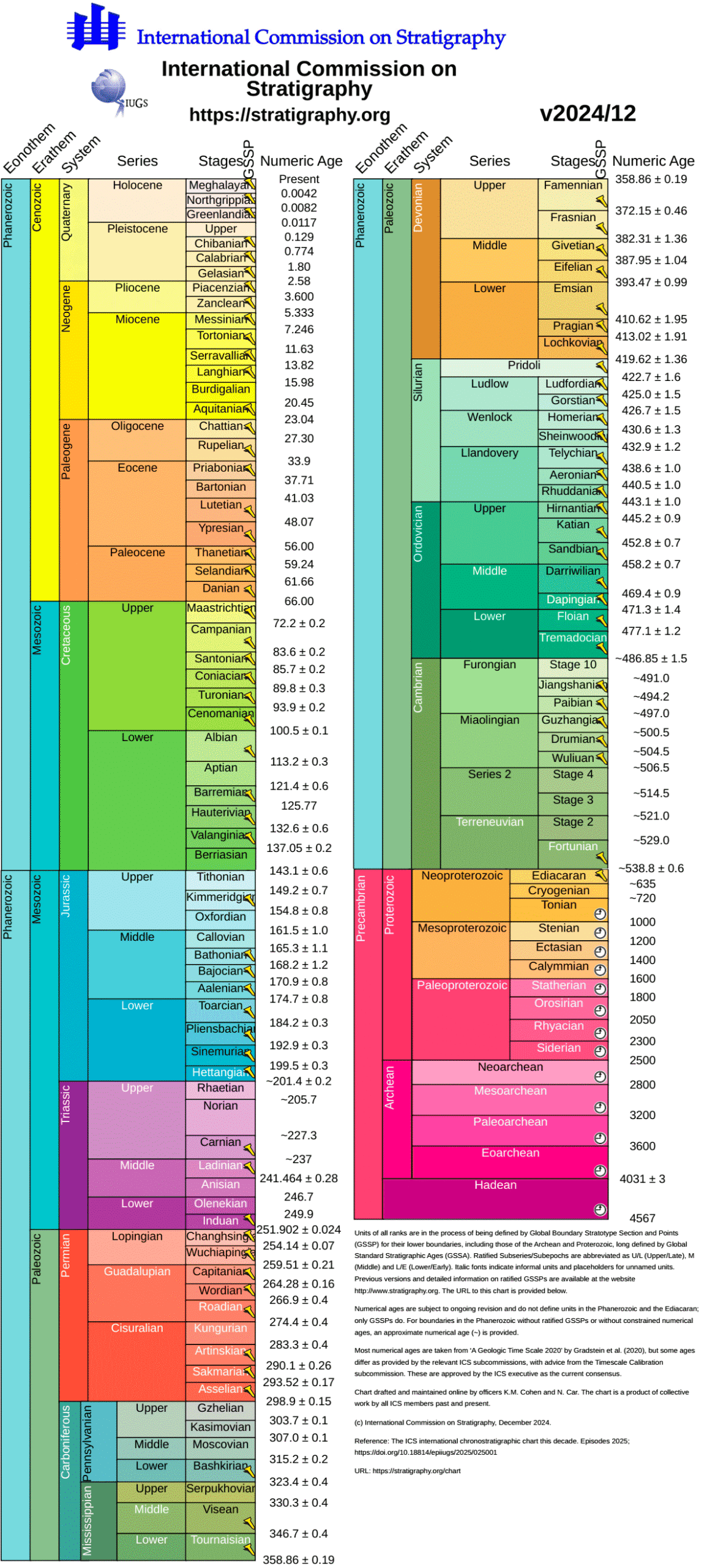
The International Commission on Stratigraphy (ICS) approves these subdivisions, and the International Union of Geological Sciences (IUGS) ratifies them. The ICS last updated the ICC scale in December 2024.
Terminology
The following key terms cover the geologic time scale’s main aspects. Hopefully, they will help you understand how geologists form and use the scale to study Earth’s history.
Stratigraphy
The branch of geology that studies the sequence, composition, and relationships of rock layers. It establishes the basis for classifying geological deposits that make up the time scale. Furthermore, biostratigraphy is a subdivision of stratigraphy that uses the distribution of fossils to determine the relative age of rock layers.
Chronostratigraphy

The science that studies the sequence and age of sedimentary and volcanic rocks, dividing them into temporal units (e.g., eons, eras, periods). It serves as the foundation for constructing the geologic time scale, linking rock layers to specific time intervals.
Geochronology
The science that determines the absolute or relative age of rocks and geological events using various methods, including paleontological and radioisotopic ones. Ultimately, it enables the dating of events in Earth’s history, providing the chronological foundation for the time scale.
Index Fossil

Index fossils come from species that spread widely but lived for only a short geological time. Geologists use them to date rock layers. These fossils must appear commonly in rock deposits. The shorter the time interval in which the species existed, the more precise the dating. Index fossils serve as a key tool for accurately correlating the ages of rock layers.
Boundary
A point in the stratigraphic record that marks a significant geological or biological event, separating temporal units. Boundaries, like mass extinctions, define transitions between periods or eras.
Correlation
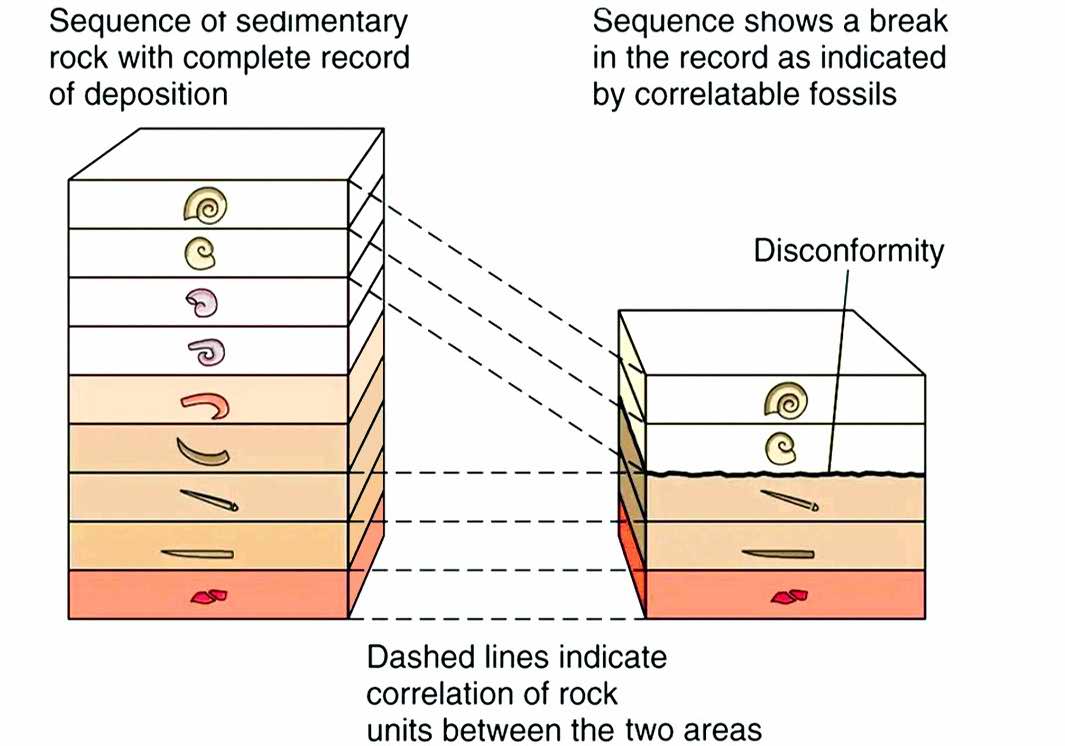
The process of matching the age and sequence of similar rock formations from different regions based on their characteristics or guide fossils. The presence of the same index fossil in different geographic locations indicates the rock layers were deposited during the same period of time. Stratigraphic correlation enables the creation of a unified global geologic time scale.
Relative Dating
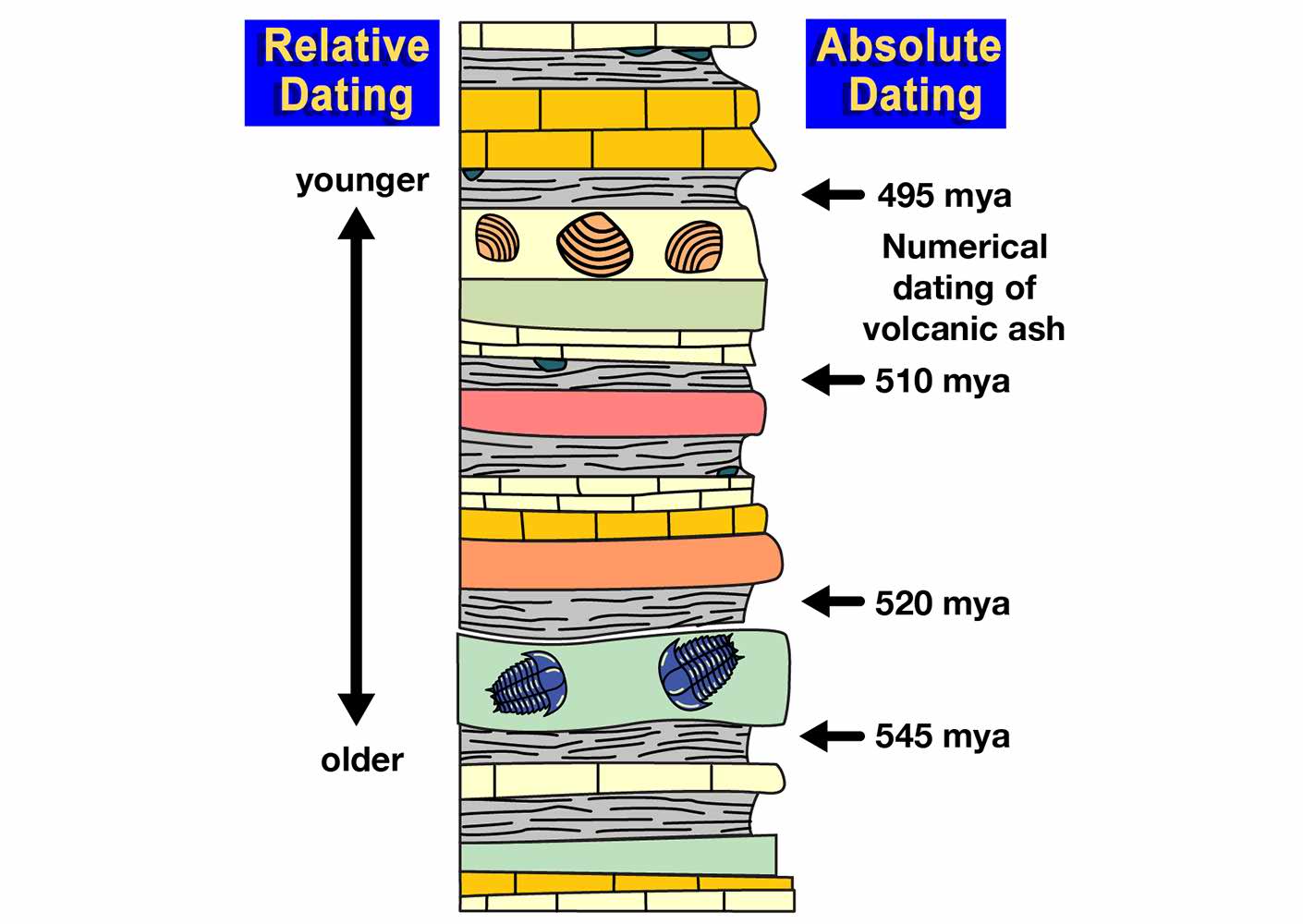
A method of determining the age of rocks based on their relative positions and fossil contents without specifying exact years. By identifying specific index fossils in various layers, geologists can establish which layers are older and which are younger relative to one another. This method forms the basis for constructing the sequence of events in the time scale.
Absolute Dating
A method of determining the age of rocks in years using radioisotopic or other quantitative techniques. It complements relative dating by refining the temporal frameworks.
Numerical Time Units
Numerical values in the International Chronostratigraphic Chart are expressed in units of Ma (megaannum, for “million years”). Scientists also widely use Ga (gigaannum, billion years) and ka (kiloannum, thousand years).
GSSP and GSSA
The Geochronological Time Scale uses GSSP and GSSA abbreviations. The differences between them stem from the challenges in defining and dating the bases of very old geochronological units. GSSP and GSSA represent two methods by which scientists mark the starting dates of eons, periods, and epochs in Earth’s geological calendar.

Global Boundary Stratotype Section and Point (GSSP)
Geologists often call the GSSP a “golden spike” (a badge resembling a golden nail is used in the GTS). It is an official physical marker—an internationally agreed-upon point in a specific, accessible layer of rock.
It physically defines the beginning (lower boundary) of a geological period based on a clear, natural change in the rock deposits (e.g., the first appearance of a specific fossil or a sharp change in rock composition). This is the preferred standard for defining geological time.
Global Standard Stratigraphic Age (GSSA)
GSSA is a temporary date placeholder. It is an arbitrary age in millions of years (e.g., “the period began 635 million years ago”) that the scientific community has agreed to use as a provisional boundary.
Geologists use GSSA only when they have not yet identified or agreed on a suitable GSSP. This applies primarily to the earliest periods of Earth’s history, when geological records are often too complex, damaged, or incomplete. The goal is to replace all provisional GSSAs with physical GSSPs eventually.
Some Terminology Suggestions
Zalasiewicz et al. (2004) proposed abandoning the distinction between the dual stratigraphic terminology of temporal units (chronostratigraphy) and geological time units (geochronology). It is a bit like having two calendars for the same events—confusing, right? In their opinion, chronostratigraphy should define eons, eras, periods, and so on in relation to rock formations, and geochronology should refer to the numerical dating of the age of rocks and fossils.
They also suggested a small but meaningful tweak in terminology. Instead of calling rock layers “lower” or “upper,” which sounds like a stack of pancakes, they recommended using “early” and “late.” It is a subtle shift, but it helps us think in terms of time rather than just depth.
Overcoming Regional Differences
However, in the course of such work, differences accumulate in the placement of boundaries between stratigraphic elements, in the ways these elements subdivide into smaller components, and in the names of the subdivisions themselves across various regions of the planet. These differences appear particularly in Russia, North America, and Europe.
Regional rules and traditions differ somewhat from international ones. Therefore, when we use only terms approved by the ICS (International Commission on Stratigraphy), it can sometimes prove difficult to understand which period of time we refer to and how various regional stratigraphic elements relate to each other.
Many countries use their own variations of the time scale, based on geological observations within their national borders. As a rule, this only makes sense for countries with the largest areas (e.g., Russia, Canada, China), where extensive geological data and a sufficient volume of work can serve as the basis for dividing the timescale.
Aligning with the ICS
One of the key goals of the ICS (International Commission on Stratigraphy) is to overcome regional differences and make decisions on divisions and timescales of events that are global. This standardizes the application of lithostratigraphic terminology and improves the understanding of Earth’s history.
Therefore, to resolve this issue, we developed a more comprehensive chart based on the approved International Chronostratigraphic Chart (ICC). This geological time scale combines the most commonly used regional subdivisions with some alternative and obsolete ones. The timescale is presented in full accordance with the data from the International Chart; names ratified by the ICS are shown in bold, while the boundaries of all regional subdivisions are for reference only. The geological time scale also corresponds to the color codes established by the ICS in the official International Chronostratigraphic Chart.
Ages-New02-for-siteWikipedia features a page titled List of geochronologic names, which compiles both official and unofficial names for time intervals used in the geological time scale and chronostratigraphic units. Still, it does not include all regional subdivisions.
Early Stages in the History of Earth and the Universe
In the early 2010s, a group of researchers proposed extending the geochronological time scale far beyond the traditionally accepted Precambrian—reaching back to the formation of the Solar System and even earlier.
Goldblatt et al. (2010)1 introduced a new scheme for subdividing the Hadean eon into periods and added an era—the Chaotian—which pushes the geological time scale further back to the time of Solar System formation. Later, Van Kranendonk et al. (2012)2 refined this scheme, and Shields et al. (2021)3 suggested modifications for the pre-Cryogenian interval of geologic time.
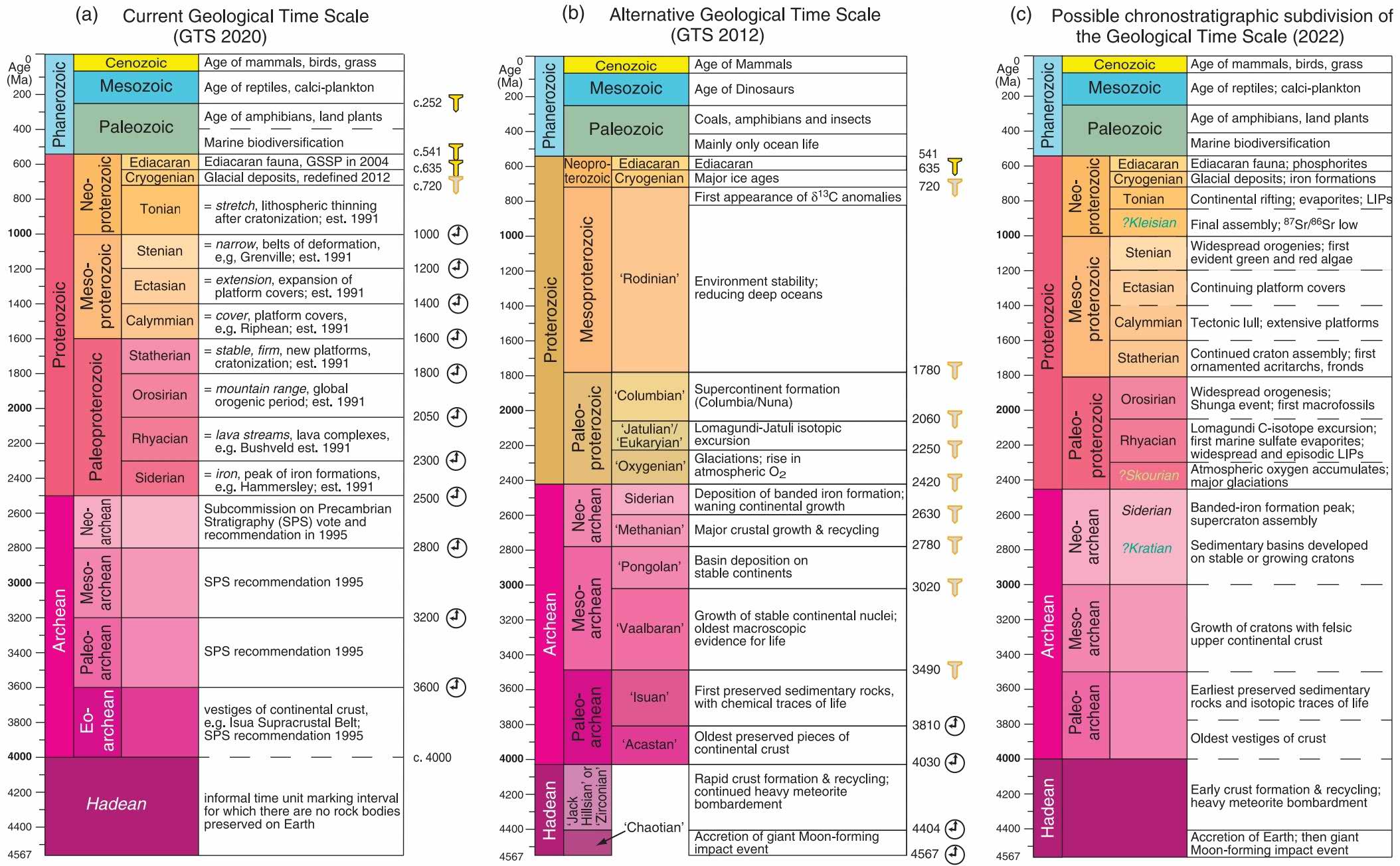
These interpretations of the Hadean subdivision are generally based on a combination of ideas from Goldblatt and the GTS 20124 time scale, with some elements of the same scale also applied to the Archean. However, we must note that the International Subcommission on Precambrian Stratigraphy has not yet officially approved these proposals, since they involve scientific and methodological uncertainties. We present them here solely as an example of how concepts about the earliest stages of geological history continue to develop.
Hypothetical Preceding Eons: Theochronic and Proteimeran
As part of a conceptual proposal to extend the geological time scale beyond the existence of Earth—and even beyond the Solar System—two hypothetical eons, namely, Theochronic and Proteimeran, were introduced into the GDS 2.0 system as a kind of “meta-level” of geological time.
Theochronic eon (from Greek Theos—god, and chronos—time, meaning “God’s Time”) encompasses a hypothetical interval before the Big Bang, spanning from an undefined moment “outside of time” to the beginning of our Universe. In essence, it symbolizes a state preceding creation and, in a sense, represents a philosophical rather than a physical category of time.
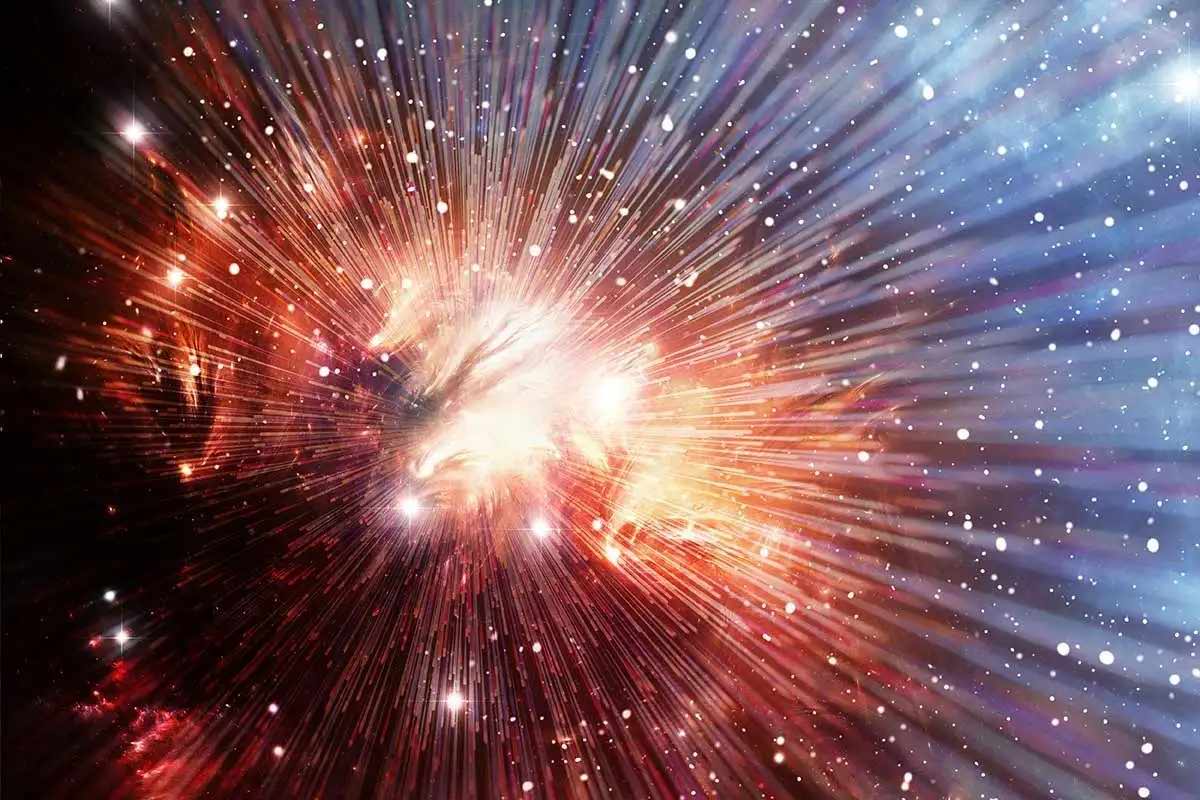
Proteimeran eon (from Greek protos—first, and hemera—day, meaning “First Day”) follows, beginning with the Big Bang and continuing up to the formation of proto-Earth. It includes the processes of formation and evolution of the present-day Universe, the Milky Way galaxy, the solar system, and other known planetary systems. Allegorically, the Proteimeran can be seen as the “first day” of cosmic creation.
Subdivisions of the Proteimeran Eon
The internal structure of the Proteimeran eon reflects key stages in cosmic evolution:
Paleoproteimeran Era—Begins with the Big Bang, includes the formation of elementary particles and the first stars, and ends with the emergence of the earliest galaxies.
- Precelestial Period. It starts with the birth of our Universe (the Big Bang) and ends with the formation of the first celestial bodies. During this time, the four fundamental physical forces—gravitational, strong nuclear, weak nuclear, and electromagnetic—separate from one another.
- Paleocelestial Period. It begins with the formation of the earliest celestial bodies and concludes with their assembly into the first galaxies. Early stars ignite, therefore emitting light for the first time through thermonuclear reactions.

Mesoproteimeran Era. Encompasses the epoch of galactic development and ends when the solar nebula becomes distinct from the Giant Molecular Cloud.5
- Eogalactic Period. It begins with the emergence of the first galaxies, and their formation continues throughout this period. It concludes with the formation of the Milky Way.
- Neogalactic Period. It starts with the birth of the Milky Way galaxy and ends when the solar nebula separates from the Giant Molecular Cloud. Subsequently, during this time, the Milky Way gradually takes on its modern structure.

Neoproteimeran Era. This era begins when the solar nebula becomes an isolated system and ends at the moment when the Sun first ignites and proto-Earth takes shape.
- Nephelean Period. Begins when the solar nebula becomes a closed system relative to the Giant Molecular Cloud and ends with the formation of the Protosun, which has not yet emitted light.
- Erebrean Period. Starts with the emergence of the Protosun, still dark and inactive, and ends when it transforms into the Sun, emitting its first light as gravitational compression triggers thermonuclear reactions.
* * *
Thus, the proposed hypothetical eons—Theochronic and Proteimeran—along with their subdivisions, represent an attempt to merge cosmological and geological history into a unified time scale, spanning the journey from hypothetical existence to the beginning of Earth’s formation. Although these ideas remain speculative and official stratigraphy does not recognize them, they reflect scientists’ ambition to encompass the full range of material existence—from the universe’s birth to our planet’s emergence.
- Goldblatt, C., Zahnle, K. J., Sleep, N. H., and Nisbet, E. G.: The Eons of Chaos and Hades, Solid Earth, 1, 1-3, doi: 10.5194/se-1-1-2010, 2010 ↩︎
- Van Kranendonk et al., 2012. A chronostratigraphic division of the Precambrian: Possibilities and challenges. ↩︎
- Shields, Graham A.; Strachan, Robin A.; Porter, Susannah M.; Halverson, Galen P.; Macdonald, Francis A.; Plumb, Kenneth A.; de Alvarenga, Carlos J.; Banerjee, Dhiraj M.; Bekker, Andrey; Bleeker, Wouter; Brasier, Alexander (2022). “A template for an improved rock-based subdivision of the pre-Cryogenian timescale”. Journal of the Geological Society. doi: 10.1144/jgs2020-222. ↩︎
- Gradstein et al, 2012. On The Geologic Time Scale. Newsletters on Stratigraphy, DOI: 10.1127/0078-0421/2012/0020 ↩︎
- Giant Molecular Cloud (GMC) – A cool cloud of great size within which stars, planets, and other stellar system objects are formed from substances such as hydrogen and helium molecules and dust. ↩︎













